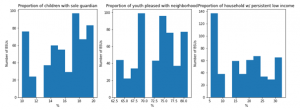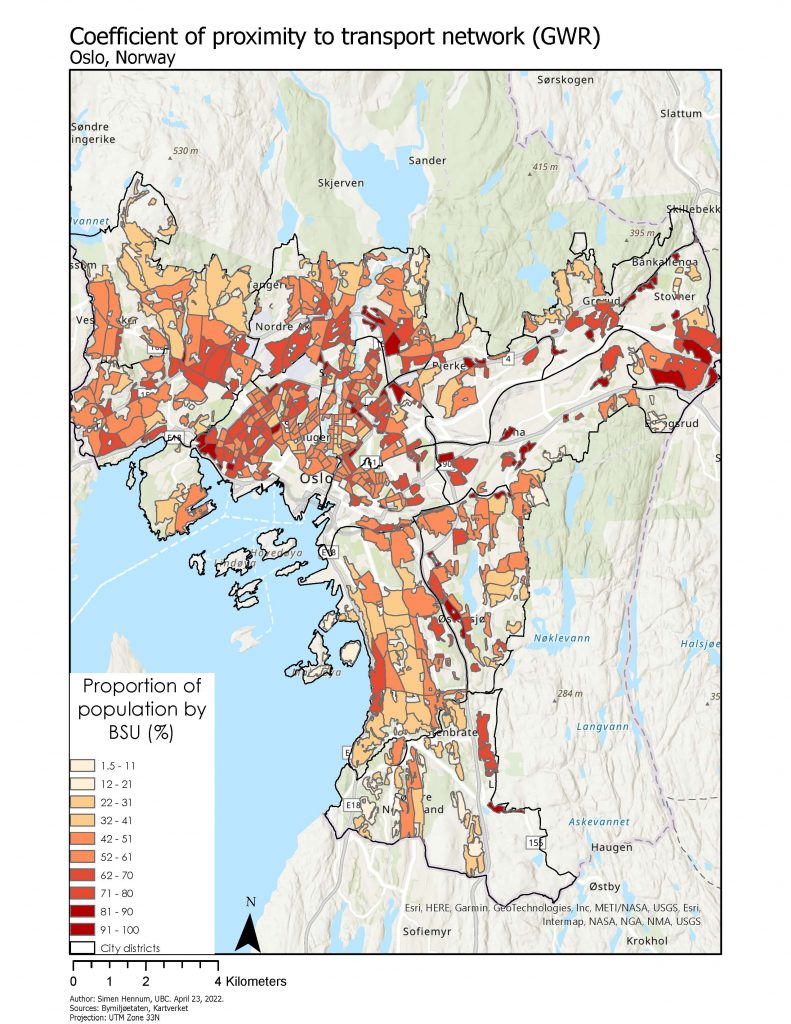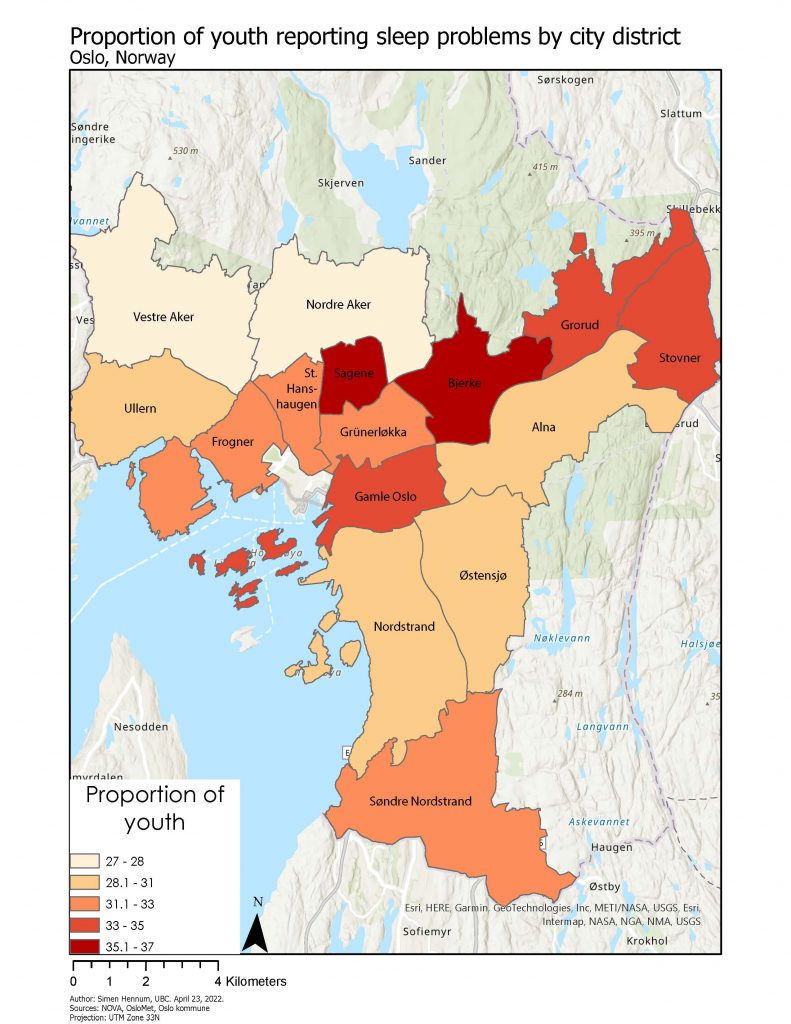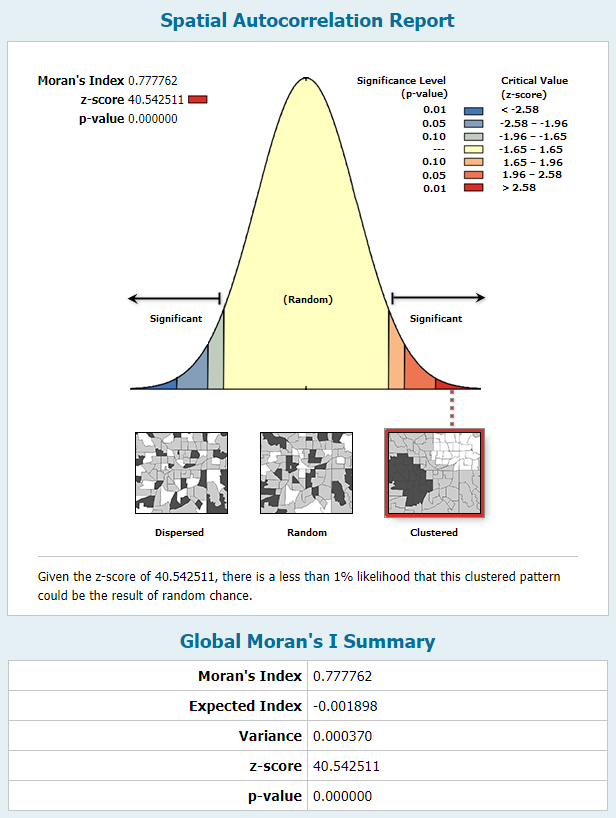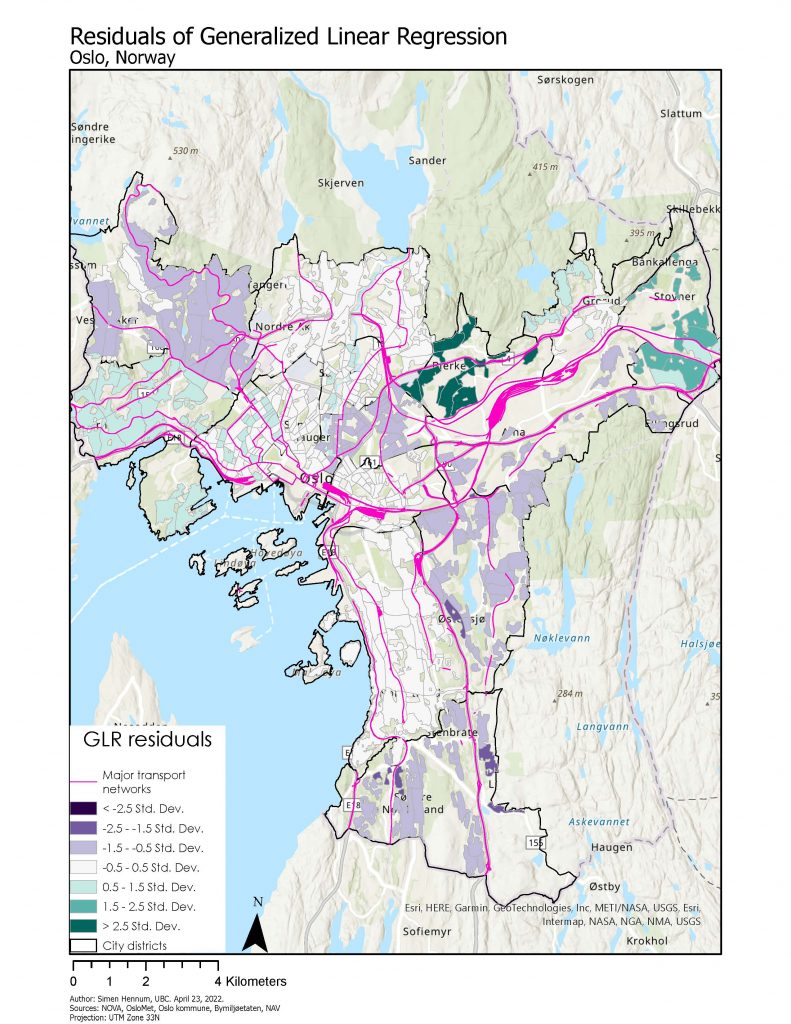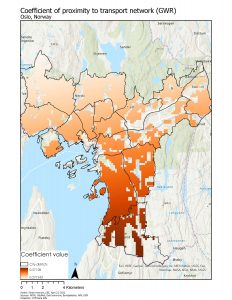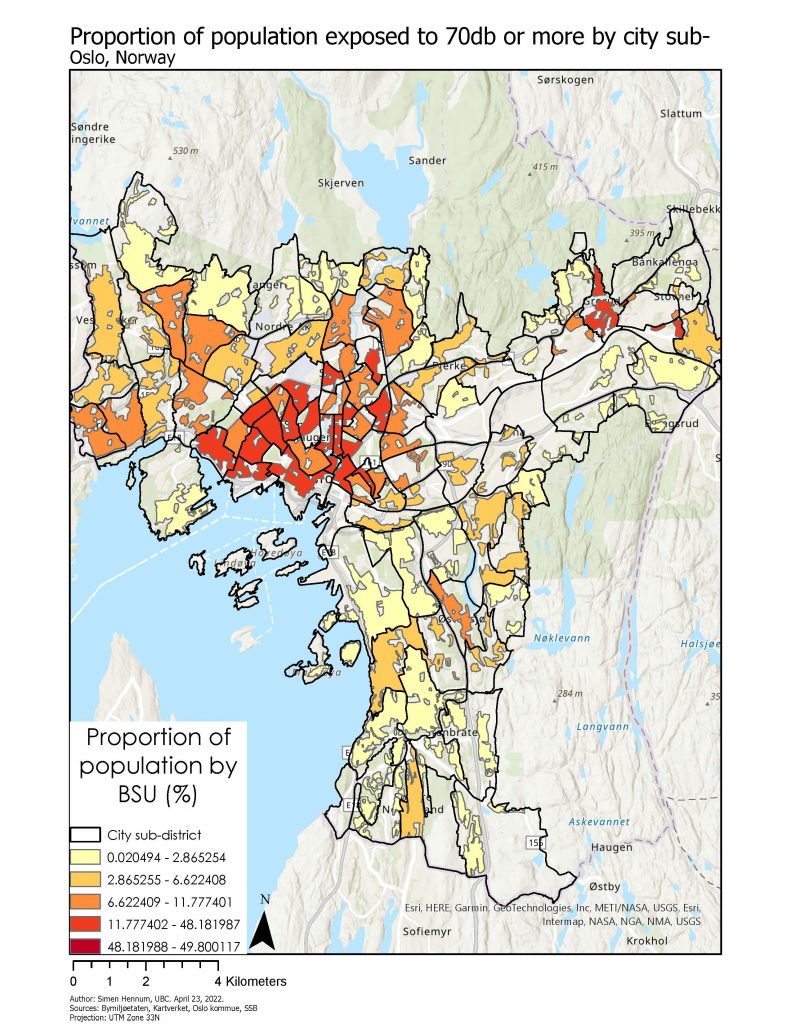Histograms for the variables included considered as candidate explanatory variables and the dependent variable were created in ArcGIS Pro (Fig 2). Most of the data is relatively normally distributed, except for the proportion of people exposed to decibels higher than 80db, which is to be expected.
Fig 2. Histograms of variables
A table for pairwise correlations was computed (Fig 3). Of the candidate explanatory variables, BSUs with a high proportion of children with a sole guardian, crowded households, and households with persistently low income were the most strongly correlated with proportion of youth with difficulties sleeping (Fig 3). Other socioeconomic variables were also strongly correlated, indicating that Oslo is a divided city when it comes to living conditions and socioeconomics. Some of these variables exhibit multicollinearity
Importantly, the proportion of people exposed to noise levels above 55 and 80 decibels were not strongly correlated with any of the other variables. Weak correlations are apparent between neighborhoods with noise levels above 55db and neighborhoods with a high proportion of crowded households.
 Fig 3. Pairwise correlations with >0.6 highlighted in red
Fig 3. Pairwise correlations with >0.6 highlighted in red
Noise pollution is most common around major roadways to the west, south, and north in the city (Map 1). The areas with high noise pollution are not necessarily the same areas as where people live. When calculating the proportion of an area covered by high noise levels, we can obtain maps with much greater detail of where people are potentially impacted by high noise levels (Map 5). Areas close to the city center, as well as to the west and east of the city, see a high proportion of area with high noise pollution.
Sleep problems also appear to exhibit a spatial pattern where the city districts of Sagene and Bjerke have up to 37 % of youth reporting difficulties sleeping (Map 6), and city districts to the northwest of the city such as Vestre and Nordre Aker reporting proportions between 27-28 %.
Regression analysis
The results of the Generalized Linear Regression using the variables identified in the exploratory regression step indicate that the model is significant (Table 4, Table 5). The variables are all statistically significant, exhibit no multicollinearity, and report an R2 value of 0.81. Wellbeing at school explains 21 % of the variation in sleep scores, indicating that in neighborhoods where youth are dissatisfied with school, sleep problems are more common. The same applies to being pleased with one’s neighborhood, with a coefficient of -0.11. Neighborhoods with higher proportions of children with a single guardian provides the most explanatory power for the variation of sleep problems in BSUs, with a coefficient of 0.59. Proportion of people living in a neighborhood with 55 decibels or more does not provide significant explanatory power, but is a significant variable. Neighborhoods with proximity to major transportation networks adds significant explanatory power to the model with a coefficient of 0.27.
Table 4: GLR coefficient summary
| Variable | Coefficienta | StdError | t-Statistic | Probabilityb | Robust_SE | Robust_t | Robust_Prb | VIFc | ||||
| Intercept | 49.107828 | 2.259556 | 21.733394 | 0.000000* | 1.783435 | 27.535534 | 0.000000* | ——– | ||||
| Proximity to major transport network | 0.272638 | 0.107732 | 2.530700 | 0.011667* | 0.105934 | 2.573656 | 0.010330* | 1.079215 | ||||
| Proportion of population exposed t0 >55db | 0.006608 | 0.002382 | 2.774734 | 0.005723* | 0.002892 | 2.285236 | 0.022684* | 1.054896 | ||||
| Wellbeing at school | -0.210991 | 0.021807 | -9.675363 | 0.000000* | 0.014766 | -14.289274 | 0.000000* | 1.339407 | ||||
| Pleased with neighborhood | -0.111704 | 0.010834 | -10.310148 | 0.000000* | 0.012297 | -9.083639 | 0.000000* | 1.208539 | ||||
| Lone Parent | 0.590139 | 0.020565 | 28.696259 | 0.000000* |
|
|
|
|
Table 5: GLR diagnostic
| Input Features | BSU Map | Dependent Variable | Sleep problem |
| Number of Observations | 528 | Akaike’s Information Criterion (AICc)d | 1686.813443 |
| Multiple R-Squaredd | 0.814376 | Adjusted R-Squaredd | 0.812598 |
| Joint F-Statistice | 458.026847 | Prob(>F), (5,522) degrees of freedom | 0.000000* |
| Joint Wald Statistice | 7819.141369 | Prob(>chi-squared), (5) degrees of freedom | 0.000000* |
| Koenker (BP) Statisticf | 108.833112 | Prob(>chi-squared), (5) degrees of freedom | 0.000000* |
| Jarque-Bera Statisticg | 117.217406 | Prob(>chi-squared), (2) degrees of freedom | 0.000000* |
The Moran’s I for the residuals of the GLR are clustered, with a statistically significant Moran’s I at 0.77 (Fig 4). When running the spatial autocorrelation tool in ArcGIS Pro, I deemed that the conceptualization of spatial relationship that best works with this data is zone of indifference, where polygons not only in the same city district are considered in the calculation of Moran’s I.
Fig. 4: Spatial autocorrelation report
The spatial clustering of the residuals may be due to the BSUs inheriting the values for some of the variables from their parent city district. That is, polygons have neighbors with identical data values for a few of the variables. When running the spatial autocorrelation tool at the city district level, the Moran’s I was not statistically significant, likely due to the few numbers of observations (n=15).
Interestingly, the model underpredicts sleep problems in areas surrounded by large transport networks, suggesting that the model is still not accounting for some of the spatial variables driving sleep problems in the city (Map 7).
Geographically weighted regression
The results of the GWR do not provide particularly meaningful additional insight into the processes being studied. The variation of sleep variables was too low between different neighborhoods for the golden search method to detect at least one neighborhood. Only when defining the neighborhood type by a distance band of 100 kilometers, did the tool successfully run. The variation of coefficients between each area of the city was negligible (between 0.27128 and 0.271243 for proximity to transportation network) (Map 8, included for reference only).
Given that the GWR did not produce any meaningful results, I chose to explore whether there were any associations between noise levels and the one socioeconomic variable publicly available at a finer spatial scale – income. Using the same method as for the BSUs, I calculated the proportion of an inhabited areas of city sub-districts coinciding with noise levels above 55 and 70 decibels (Map 9). Income level was represented by the proportion of households with at least one child younger than 18 years old with low income (as defined by the European Union).
For both noise levels above 55 and 70 decibels, the weak positive associations between income and noise were not statistically significant (p-values of 0.76 and 0.43, respectively) (Fig. 5).
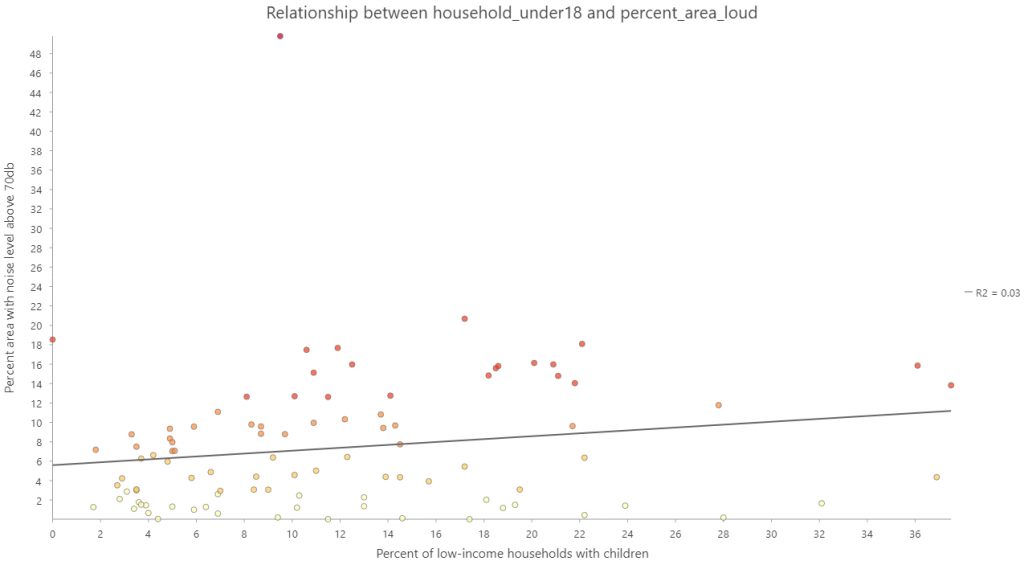 Fig. 5: Scatterplot of income and noise level variables at city sub-district scale
Fig. 5: Scatterplot of income and noise level variables at city sub-district scale
Next: discussion & limitations


